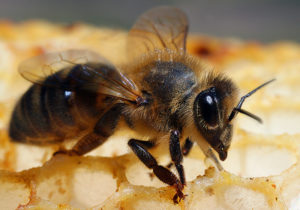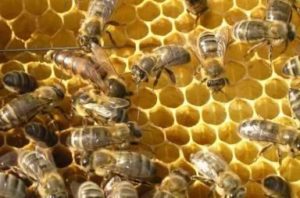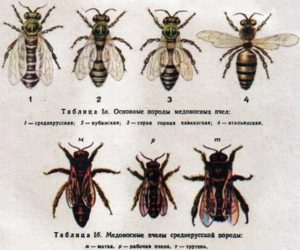the Central bee
 the Central bee: specifications, populations and hybrids.
the Central bee: specifications, populations and hybrids.
This bee – This is almost the most common breed in Russia, particularly in Bashkortostan.
Here they are in their original form Thoroughbred, although nowadays quite common because mixed breed, beekeepers who seek to expand their apiaries by individuals of other species.
In the Western Europe this species of bees and does can be considered endangered, because there is much higher mating, than under the Russian Federation.
Today this breed has many populations, which allows to conclude, it is superporodoyu and can survive in almost any environment.
Main characteristics of Middle bees
- Color: chitin individuals working uniform dark gray color without yellow and other colored inclusions.
- Large enough bees, which in comparison to other breeds almost always exceed them in size.
- Malicious bees.
- If the beekeeper for some reason looks into the hive, then insects can spovzty the bottom of the hive and hang it in the form of "beard".
- proboscis of 6 to 6,5 mm (depending on the season, population, residence).
- The average weight of individual labor 110 mg, while fruitful womb can reach 210 mg (barren – 190 mg).
- Prone to frequent swarming process.
- Long wintering: prefer "peresydzhuvaty" winter from mid-autumn to May.
- Survive in harsh climates, especially revered by beekeepers northern regions.
- Developed immunity to these diseases bee, how nosema toxemia and valleys.
- Afraid of bee moth.
- During winter in the nest numerous losses will be minimal.
- Printing on honey, dried, predominantly white.
- The uterus can not live together, change each of them is restless.
The history of the breed and spread
Close 8 000 years ago this kind of bees began to spread throughout the forests, vidrostaly that after the Ice Age.
Particularly frequent in Europe, in all its parts. During the natural process of development of new territories can be found on the Balkan Peninsula and the Pyrenees to the Urals.
In Russia the bees were well pryzhyvatysya only after, as there were massive planting linden trees.
Around 18 century they were brought to Siberia, they are not only able to survive, but even tempered, strengthen the immune system and actively began to spread.
Then they went towards promoting Central Asia, then they conquered the Baikal and went further.
Read more: How many bees in the hive?
Since most of them was in the northern areas with long winters, short summers and harsh climate over, then the Central bee developed resistance to the winter climate, endurance, immunity from certain diseases.
through the, that are collecting honey little, bees actively and vigorously involved in it. This breed can be called one of the most.
Features breed
This type of bees naturally attracted not so much honey plants. So, preferably linden and buckwheat. It is very difficult to move from one plant to another and do not seek to find new honey plant.
 An interesting fact is, in hot weather bees are storing honey less, than at low temperatures.
An interesting fact is, in hot weather bees are storing honey less, than at low temperatures.
On the one hive can collect an average of 18 to 30 kg medulla season. Uterine this breed bees laying eggs differ good.
Under favorable conditions, only a day more than it can delay 2 000 eggs, which is very high result. If the uterus is young and gives a good offspring, it can be a great limiting factor for the start of swarming – it restrains.
Also from swarming uterus can save rejuvenation. It is, if it has not reached the age of two, Swarming it can not be afraid. If low medosbora bees do not seek to limit somewhat the uterus in oviposition.
They mostly spend all their honey supply is the cultivation of new species. For good wintering bees need the Central sufficiently small amount of food. So, one street will take about a kilogram of honey.
Good performance, fast results in medosbora, and special endurance makes this breed very popular. Working bees fly with the first rays of the sun, a complete collection already dark (important that the temperature did not fall below 10 degrees, was windless and dry weather).
Even in the intense heat they continue their work, with the only condition – hive location in the shadow zone. But, usually, in hot weather their production somewhat less, than in normal climatic conditions.
Ideal conditions are those, when the temperature is within 13-14 C.
Despite the fact, bees belong to the aggressive breeds, the attack on other species nest for the purpose of theft, bee trying to leave the nest and do not want to engage in a fight for its prey.
On examination nest beekeeper as they try to escape, so fall to the bottom of the hive, hang "clusters", hiding in inaccessible places glance.
Speaking about the development of individuals in this species, it is later, but this is offset by large egg uterus. The uterus develops almost to the last days of winter, and all spring and summer is able to make the clutch.
The peculiarity of this type is the one factor, that in one nest can not peacefully coexist two uterus, as one can easily arrange the southern rock. Here, each individual should be provided uterus own family, your house without competition problems.
Only in this case will be provided with good medosbor. Suitable conditions for living medium bees are those regions, which indicates prolonged winter with severe frosts, that is not true of other varieties of bees.
Bees are different breeds of the Central possibility of a large amount of wax, allowing them to quickly rebuild cell and carry out necessary repairs housing.
honey, mined rock
Apparently, Bookmark the main feature of honey bees is this kind is, they honeycombs between the walls and leave little deposits clearance, which contains air. 
It is, It is this feature that guarantees a sweet honey scent of sweet and cloying taste.
Printing of honey bees serednorosiyskyh always dry and mostly white. This breed never makes so-called "wet" honey and this is their main advantage. Honey bees are the extensions immediately to the store and then translate it back, where is brood.
Beekeeper must be taken into account this fact and pay attention to this feature when pumping honey, not to leave their bees without food. This breed is never sent to steal from others.
Advantages of the breed
- Even with the meager capacity to collect honey can grow good brood, so as not to restrict the uterus in the masonry, that is not the southern rock.
- From the early to mid summer season uterus repeatedly pauses for eggs, worker bees stocked to the largest possible amount of honey. Under favorable conditions, they do it very well, because the volume of domestic zobik, responsible for the amount of honey, in the medium specimens large enough, allowing for more time to bring.
- Since the second half of summer does not provide great trick, bees pay much attention to his family and growing brood, and preparing for winter.
- Caring for the bees should be carried out promptly and efficiently, because they do not tolerate mistreatment, different in this case and try to sting zloblyvistyu, if they do not like something.
- It is well tolerated even severe winter.
- Immunity to a number of bee diseases.
- For a short time able to collect a considerable amount of honey.
- fertile womb.
- It is well suited for cultivation in the northern regions of Europe and Russia.
Populations and hybrids
Little of, this kind of bees is different from other, so even within his own family is not uniform. Serednorosiyski bees during its existence has acquired numerous populations.
 Among them Bashkir, Tatar, altayska, Woodland, Hearne taiga, burzyatskaya, but there are other, a smaller.
Among them Bashkir, Tatar, altayska, Woodland, Hearne taiga, burzyatskaya, but there are other, a smaller.
Very popular among beekeepers use it Bashkir Bee, because they are different breeds purity (come from the dark European bdzholosim'yi). They live mostly in protected areas.
This population is considered the most stable, as the most experienced adverse climatic conditions. It is, it is better for all zahartuvalasya and become more durable. These bees are not afraid of freezing temperatures, brood as they may appear in February.
Despite the fact, in the woods still be lying snow, In March they will already be doing circled. Burzyanskyy kind of prone to a large percentage of swarming, therefore not particularly desirable to breeding on private apiary.
They are very sensitive to temperature. Stealing is not marked. The disadvantage of this type is also considered the fact, they can gnaw Wax. Each population is different from their relatives.
Hearne taiga is perfect for a variety of conditions Urals and taiga, why, and got its name. In early March, even if the temperature does not exceed 4 ° C, are capable of early departures.
Perfectly feel in the rain, cloudy weather and even strong winds. During the main medosbora can work to 16 hours a day.
Altai subspecies is not particularly propensity to swarming, but some time is able to undergo this process 90% families. Swarming is the period before 55 days.
This subspecies in a special sealed cells: on the faces lids can see little bump, resembling curls pale yellow.
In Europe there are altogether subspecies, who do not live in Russia, and vice versa.
Video




3 Responses
[…] Ukrainian steppe species of bees — view, formed in the central and southern Ukraine, which has many similarities with the Central bee. […]
[…] Far compared with the Central bee, as they like most. so, first, that strikes […]
[…] a research institute by crossing the Central and Caucasian […]